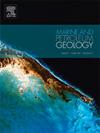鄂尔多斯盆地中三叠统长7段氮循环和钼铀富集的主控因素:对巨型高产湖氧化还原和超有机富集的启示
IF 3.6
2区 地球科学
Q1 GEOSCIENCES, MULTIDISCIPLINARY
引用次数: 0
摘要
鄂尔多斯盆地延长组长7段(~ 241.5 Ma)黑色页岩沉积过程中,发育了一个巨大的深多年生湖泊。该沉积物代表了大量的有机碳埋藏,是研究二叠纪末大灭绝(EPME)后生态系统恢复和环境演变的重要焦点。由于火山-热液活动和陆源碎屑输入的潜在影响,氮(N)和氧化还原敏感微量元素富集的主要控制因素尚不清楚,导致从这些指标推断的湖泊氧化还原条件仍在争论中。本研究探讨了深湖相岩心中N种不同同位素组成和氧化还原敏感微量元素(RSTEs)富集的主控因素。可以得出以下结论:(1)高全氮含量(平均1.11%)和无机氮含量(占全氮的65%)可能受到陆源碎屑输入的影响。这种输入也影响了N同位素组成,导致总体δ15Nbulk值小于δ15Nker(干酪根的δ15N)值(平均为2.4‰)。其他沉积后因素,包括热成熟度和残留油,对有机N同位素的影响不显著,从而提高了它们对N循环分析的可靠性。(2)长7烃源岩Mo、U富集显著,MoEF值为90.8,UEF值为13.9,主要受底水缺氧-缺氧条件下金属硫化物和有机质的强吸附控制,并有热液活动的额外输入。(3)在缺氧-缺氧的底水条件下,δ15Nker值适中(~ 4.5‰),且较深相δ15Nker值减小,表明湖缘附近存在深部氧化还原化斜带,成矿氧最小值。氮循环主要以反硝化作用为主,固氮作用有显著贡献,而硝酸盐和铵是金属氧最小值的主要生物限制营养素。全球变冷促进了EPME后的生态恢复,局部火山热液活动增强了风化和养分输入,这些因素可能促进了这个大湖缺氧底水的初级产生和发展,最终促进了有机物质的异常积累。本文章由计算机程序翻译,如有差异,请以英文原文为准。
Main controls on nitrogen cycling and Mo-U enrichment of the Middle Triassic Chang 7 Member in the Ordos Basin: Implications for redox and ultra-organic enrichment in a giant highly productive lake
During the deposition of the Chang 7 Member (∼241.5 Ma) black shale from the Yanchang Formation in the Ordos Basin, a giant and deep perennial lake developed. This deposition represents a substantial organic carbon burial, and this lake serves as a significant focus for investigating the ecosystem recovery and environmental evolution following the end-Permian mass extinction (EPME). Due to potential influences from volcanic-hydrothermal activity and terrigenous detrital input, the primary controls on nitrogen (N) and redox-sensitive trace element enrichment remain unclear, leading to ongoing debates regarding the lake's redox conditions inferred from these proxies. This study examines the main controls on the different isotopic compositions of N species and the enrichment of redox-sensitive trace elements (RSTEs) in deep lake facies drill cores. The following conclusions can be drawn: (1) The high total N content (averaging 1.11 %) and inorganic N content (accounting for 65 % of total N) are likely influenced by terrigenous detrital input. This input also affects N isotope composition, leading to summarized results of bulk δ15Nbulk values being lower than δ15Nker (δ15N of the kerogen) values (average 2.4 ‰). Other post-depositional factors, including thermal maturation and retained oil, do not significantly affect the organic N isotopes, thereby enhancing their reliability for N cycling analysis. (2) The notable enrichments of Mo and U in the Chang-7 source rocks, with MoEF values reaching 90.8 and UEF values of 13.9, were primarily controlled by strong adsorption of metal sulfides and organic matter under anoxic-euxinic bottom water conditions, with additional input from hydrothermal activities. (3) Under anoxic-euxinic bottom water conditions, moderate δ15Nker values (∼4.5 ‰) and decreasing δ15Nker in deeper facies indicate a deep redox chemocline with an metalimnetic oxygen minimum near the lake's margin. N cycling was primarily dominated by denitrification but with a notable contribution from nitrogen fixation, while nitrates and ammonium were the primary bio-limiting nutrients in the metalimnetic oxygen minimum. Factors such as global cooling, which facilitated ecological recovery after the EPME, and local volcanic-hydrothermal activities that enhanced weathering and nutrient input, may have promoted primary production and development of anoxic bottom water in this large lake, ultimately fostering the anomalous accumulation of organic material.
求助全文
通过发布文献求助,成功后即可免费获取论文全文。
去求助
来源期刊

Marine and Petroleum Geology
地学-地球科学综合
CiteScore
8.80
自引率
14.30%
发文量
475
审稿时长
63 days
期刊介绍:
Marine and Petroleum Geology is the pre-eminent international forum for the exchange of multidisciplinary concepts, interpretations and techniques for all concerned with marine and petroleum geology in industry, government and academia. Rapid bimonthly publication allows early communications of papers or short communications to the geoscience community.
Marine and Petroleum Geology is essential reading for geologists, geophysicists and explorationists in industry, government and academia working in the following areas: marine geology; basin analysis and evaluation; organic geochemistry; reserve/resource estimation; seismic stratigraphy; thermal models of basic evolution; sedimentary geology; continental margins; geophysical interpretation; structural geology/tectonics; formation evaluation techniques; well logging.
 求助内容:
求助内容: 应助结果提醒方式:
应助结果提醒方式:


